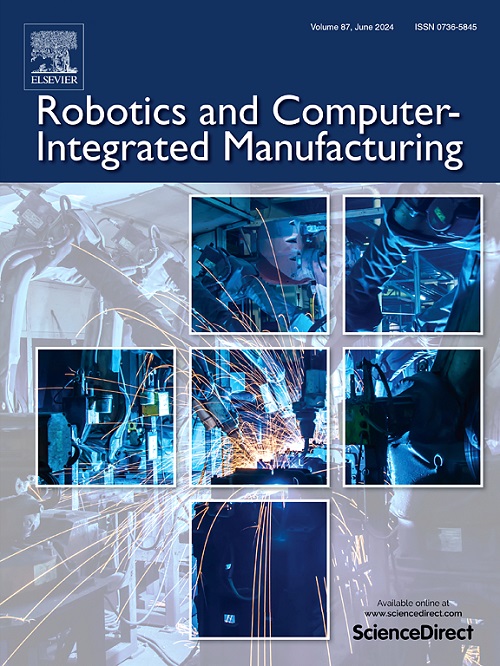改进的基于深度拉格拉格网络的动量观测器,用于人机协作中的碰撞检测
IF 11.4
1区 计算机科学
Q1 COMPUTER SCIENCE, INTERDISCIPLINARY APPLICATIONS
引用次数: 0
摘要
在人机协作(human-robot collaboration, HRC)中,机器人与人类共享工作场所,它们之间可能会有频繁的接触。能够实时检测意外碰撞是至关重要的,因此应该采取适当的安全措施,以避免对人类和机器人的伤害。然而,现有的碰撞检测策略存在挑战,例如在机器人中部署传感器以实施碰撞前安全监控解决方案或进行复杂的实验以开发碰撞后合规解决方案所产生的额外成本。为了解决这些问题,本文提出了一种新的基于动量观测器的碰撞检测方法,该方法可以有效地识别机器人碰撞引起的外部力矩。该方法包括集成改进的深度拉格朗日网络(DeLaN)来建模机器人动力学,而不需要动态参数识别实验和机器人的物理和结构参数的先验知识。该方法的另一个创新是设计了一个补偿性安全阈值,以提高碰撞检测的准确性。使用三个机器人数据集来训练改进的DeLaN模型。仿真和实际实验进一步验证了该方法的有效性。对比实验表明,该方法在速度和效率方面都优于其他动量观测方法。此外,实验表明,该方法提出的补偿安全阈值减轻了机器人关节摩擦误差引起的误报,防止了碰撞误检。本文章由计算机程序翻译,如有差异,请以英文原文为准。
Improved deep Lagragian network-enabled momentum observer for collision detection during human-robot collaboration
During human-robot collaboration (HRC), robots share workplaces with humans, and there may be frequent contact between them. It is crucial to be able to detect unexpected collisions in real-time so that appropriate safety measures should be taken to avoid injuries to humans and damage to robots. However, there are challenges with existing collision detection strategies, such as the additional costs incurred in deploying sensors in robots to implement pre-collision safety surveillance solutions or conducting complicated experiments to develop post-collision compliance solutions. To address these challenges, this paper presents a new momentum observer-based collision detection approach in which the external torques caused by collisions on robots can be efficiently identified. The approach involves integrating an improved deep Lagrangian network (DeLaN) to model robot dynamics without dynamic parameter identification experiments and prior knowledge of the robot’s physical and structural parameters. Another innovation of this approach is that a compensatory safety threshold is designed to enhance collision detection accuracy. Three robot datasets were used to train the improved DeLaN model. Simulation and real-world experiments were further carried out on the proposed approach to validate the effectiveness of the approach. Comparative experiments showed that the proposed approach outperformed other momentum observers in terms of both speed and efficiency. Moreover, experiments showed that the compensatory safety threshold proposed in this approach mitigated false positives caused by friction errors in robot joints to prevent the misdetection of collisions.
求助全文
通过发布文献求助,成功后即可免费获取论文全文。
去求助
来源期刊
CiteScore
24.10
自引率
13.50%
发文量
160
审稿时长
50 days
期刊介绍:
The journal, Robotics and Computer-Integrated Manufacturing, focuses on sharing research applications that contribute to the development of new or enhanced robotics, manufacturing technologies, and innovative manufacturing strategies that are relevant to industry. Papers that combine theory and experimental validation are preferred, while review papers on current robotics and manufacturing issues are also considered. However, papers on traditional machining processes, modeling and simulation, supply chain management, and resource optimization are generally not within the scope of the journal, as there are more appropriate journals for these topics. Similarly, papers that are overly theoretical or mathematical will be directed to other suitable journals. The journal welcomes original papers in areas such as industrial robotics, human-robot collaboration in manufacturing, cloud-based manufacturing, cyber-physical production systems, big data analytics in manufacturing, smart mechatronics, machine learning, adaptive and sustainable manufacturing, and other fields involving unique manufacturing technologies.

 求助内容:
求助内容: 应助结果提醒方式:
应助结果提醒方式:


